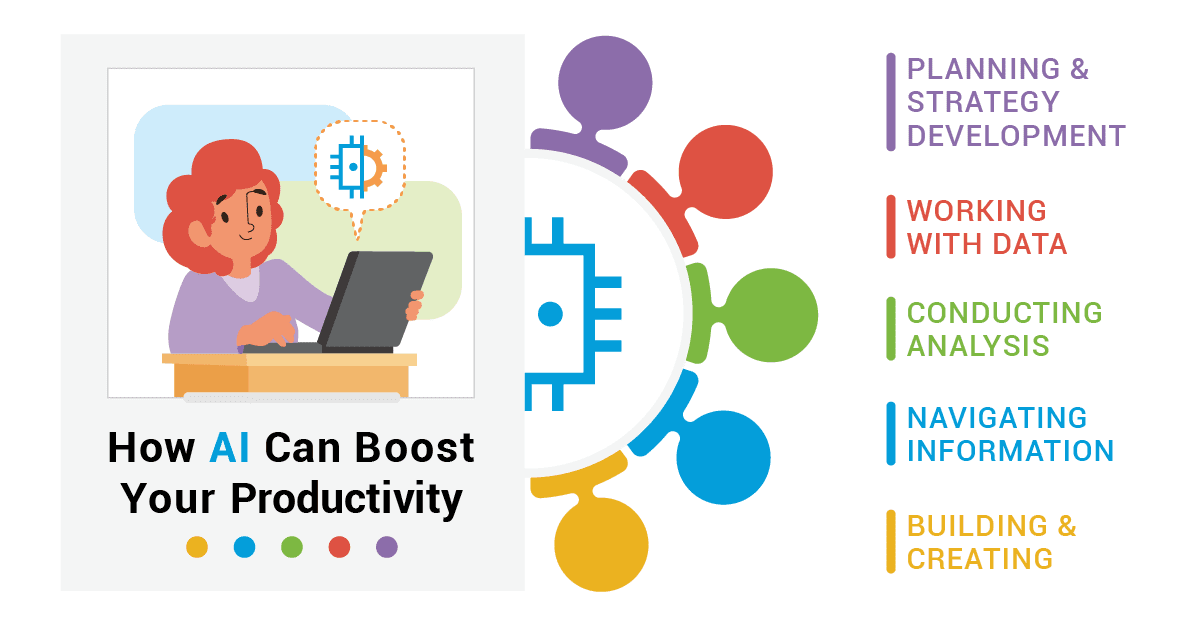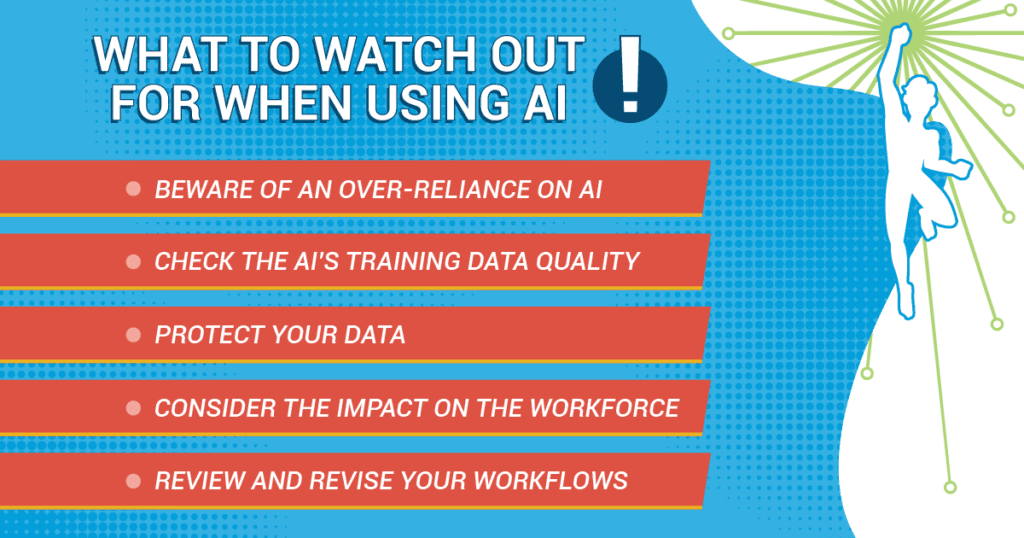In today’s fast-paced world, everyone is looking for ways to increase their productivity. One way to do this is by leveraging the power of AI.
How Artificial Intelligence Can Boost Your Productivity
AI is revolutionizing productivity in planning and strategy, enabling deeper problem understanding and streamlining brainstorming and prototyping. These smart tools enhance efficiency and foster creative solutions at every step, from concept to creation.
- Planning and strategy development
AI is reshaping how we approach planning and strategy development. By enhancing problem understanding, facilitating brainstorming, and aiding in prototyping, AI can make these processes more efficient and productive:
◦ Understanding the problem: AI assistants, such as ChatGPT, can be invaluable when it comes to problem understanding. For instance, if you are developing a training app and want to understand what features are typically expected, you can engage in a simulated dialogue with the AI. You might pose as a user of the app and describe the functionalities you’d expect to see. The AI, through a range of pre-existing user data, can suggest additional features or functionality that align with user expectations.
◦ Brainstorming: AI assistants can be a creative catalyst when brainstorming strategies. For example, if you’re looking for ways to reach out to your customers, the AI assistant could generate a comprehensive list of options based on diverse industry practices, from traditional methods like email campaigns and webinars to more innovative ideas like VR product demos or gamified surveys. This can save you time and energy, freeing up your resources to focus on refining and implementing these strategies.
◦ Prototyping: AI technology, particularly AI in architectural design software, can enhance productivity in the prototyping phase as well. For instance, if you need a blueprint for a 1500 sqft house with 3 bedrooms and 2 baths, some AI-powered software can generate a model based on these specifications, factoring in optimal space utilization and design aesthetics. While the results may not be perfect, they can serve as a useful starting point and significantly speed up the prototyping process.
- Working with data
Artificial Intelligence (AI) is democratizing data analytics by streamlining and simplifying tasks typically handled by data scientists. AI automates time-consuming tasks like data preprocessing and cleaning, ensuring clean datasets for further analysis. It enables natural language querying, allowing users to ask and receive data-related answers in everyday language. AI further aids in crafting intuitive data visualizations, making complex data patterns understandable to non-specialists. Additionally, AI offers predictive analysis capabilities, identifying trends and making future predictions based on extensive datasets, which can then be used in decision-making. AI assistants and chatbots guide users through data-related tasks, while personalized AI-powered learning experiences demystify the complexities of data analysis. Through these advancements, AI has made data analytics accessible to a broader audience, empowering those without data science backgrounds to understand and harness the power of data effectively. - Conducting analysis
AI is revolutionizing the process of data analysis by making it more accessible and understandable to a wide range of individuals, irrespective of their technical background. AI can automate many aspects of data analysis, from data cleaning to complex calculations, thus removing the need for advanced technical knowledge. This allows individuals without a deep understanding of statistical methods to still draw valuable insights from data. Additionally, many AI-powered tools now come with intuitive interfaces and built-in guidance, enabling users to carry out complex analyses with simple drag-and-drop operations or by asking questions in natural language. - Navigating information
AI can help professionals navigate through vast amounts of information quickly and accurately. For instance, AI-powered search engines can deliver precise results from a database of millions of documents in seconds, based on specific keywords or questions. Additionally, AI can summarize complex documents, identify key points, and even answer queries, reducing the time spent reading and interpreting information. - Building and creating
AI can enhance productivity in the creation process by offering automated design and prototyping tools. For example, in architecture, AI software can generate multiple design options based on given parameters (like building size, location, and purpose), enabling architects to focus on refining designs rather than starting from scratch. Similarly, in content creation, AI tools can generate drafts, suggest edits, and even create simple articles or reports, saving significant time and effort.
What to Watch Out for When Using AI

Just like the heroes in our favorite comic books, we have to be careful with our superpowers. Using Artificial Intelligence (AI) can be like having superpowers at work, helping us do our tasks quicker and better. But we need to remember that every superpower comes with responsibilities. Here’s what we need to watch out for when using AI to boost our productivity:
- Beware of an over-reliance on AI
AI is an awesome sidekick, but it’s not perfect. For example, if we ask our AI tool to plan our weekly team meetings, it might schedule them at a perfect time when no one is busy. But it might not realize that right after lunch, everyone is a little sleepy and not at their best. That’s where we come in. We need to double-check our AI’s work and make sure it makes sense in the real world. - Check the quality of the data that the AI was trained on
AI learns from data, just like we learn from textbooks. But what if our textbook had all the wrong answers? We’d be learning the wrong things! That’s why we need to make sure our AI is learning from good data. For example, if we use an AI tool to predict which products our customers will like, we need to make sure it’s learning from accurate and recent sales data. - Consider the presence of culturally sensitive material or high-stakes scenarios
AI models, especially when trained on data that contains biases, can reinforce or propagate stereotypes, leading to misinterpretations or offensive outcomes. Additionally, culturally significant subtleties can be missed or misrepresented by AI, leading to an inaccurate or insensitive portrayal. In high-stakes situations, the cost of an error is elevated. Relying solely on AI without a failsafe or human oversight can be risky. If AI makes a decision in a critical scenario, like in healthcare or criminal justice, there should be clear lines of accountability for outcomes. - Protect your data
We wouldn’t leave our superhero identities lying around for everyone to find, right? The same goes for our data. We need to make sure the AI tools we use protect our data like precious jewels. For example, if we’re using AI to analyze our customers’ shopping habits, we need to make sure it doesn’t share this sensitive information with anyone else. - Consider the impact on the workforce
Even superheroes need a team. AI might take over some tasks, but that doesn’t mean we don’t need people. If a robot starts making burgers at our restaurant, we might need fewer chefs, but we’ll need more people to maintain and program the robot. It’s important to think about how AI changes the jobs we need and help our team learn new skills if needed. - Review and revise your workflows
When we get a new superpower, we need to learn how to use it. It’s the same with AI. We need to change how we do things to make the best use of our new AI tools. For example, if our AI tool is writing our monthly report, we don’t need to spend time doing that anymore. Instead, we can use that time to think of new ideas or solve problems. In high-stakes situations, the cost of an error is elevated. Relying solely on AI without a failsafe or human oversight can be risky.